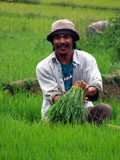language="javascript"
src="http://www.webstat.net/java.php?user=15312"></script><noscript>
<a href="http://www.webstat.net/v/" target="_blank">
<img src="http://www.webstat.net/webstat.php?user=15312"
alt="Webstat Free Counter Tracker"
July 31, 2005
Planting rice is... never fun?
CERVANTES, Ilocos Sur (July 27) — “ Magtanim ay ‘di biro. Maghapong nakayuko…” ( Planting rice is never fun, bent from the morn ‘til the set of sun…) A widely accepted Filipino folk song, it depicts the everyday life of people living in farming areas. This song describes the hardships that one endures in the planting season. This song best applies to Comillas in this town, where, it is now the season for planting rice. The surrounding ricefields the neighborhood are severe green. Upon letting your eyes wander, the calmness of the green seedlings or “binhi” circling the neighborhood soothes your eyes and makes you want to smile.
This is one of the two times in the year where the people of Comillas hereare busiest, collecting seedlings for planting. The village of Comillas, which is classified further into South and North Comillas, thrives mainly through farming. During the dry season, local residents have the opportunity to be employed in small quarrying ventures. Looking around the area, one will notice that this place is surrounded by two things — mountains and rice fields. The mountains sustain grazing animals. It also protects the ricefields against typhoons. The ricefields, on the other hand, sustain the community. At this time, the people are busy with the ricefields. Planting can last from June to August. But planting does not only mean taking a seedling and poking it in the ground. This is a process of work to be taken seriously.
The seedlings or “binhi” are from the rice grains that the people set aside from the batch for consumption or for sale. These rice grains are dried in the sun, scattered and then planted to become the beginning of another harvest. In Comillas, people prefer to plant dried rice grains. But for some who can afford or were not able to dry rice grains, high breed rice grains can be bought in the local municipal office, where three cans of high breed rice grains can be bought for P1, 800.
The planting, maintenance and the harvesting of rice is also a process, which involves a lot of cooperation and patience. After harvesting the seedlings, these are then replanted. Some people use the “straight line” system where the seedlings are planted following a straight line. The people from Comillas don’t follow such technique, though. They use the “war-ay” planting system which only requires an inkling for precision in distance to maximize the area. While other people see it being just a spontaneous planting, the farmers are actually calculating the distance between their seedlings. Some people in the area acknowledge that the women do better in calculating the area to maximize the space rather than the men. The people here consider this as a communal activity. As everyone will benefit from it, so must everyone pitch in with the work. Thus, the people in the community take daily turns in the planting of rice and all throughout the season. The men are in charge of planting in the higher and farther areas. Some people recruit their neighbors to work for their farm. Payments come in the form of rice share or sometimes, as wage. The women receive P60 daily while men are paid P70, inclusive of food all throughout the day. As for maintenance, farmers usually battle with field rats, snails, and sometimes, flooding. Fertilizers used include urea, for people who have money or “green manuring” or the bedding of leaves and cow dung in idle lands after the harvest to nurture the soil for the next planting. Pesticides and fertilizers are too expensive.
Harvesting is done after at least 110 days or four months of waiting. Soon, fields of gold and yellow will emanate in these once green lands. People are busy reaping what they sowed and actually holding the fruit of what they worked hard for. After harvesting, those who worked for private rice field owners can have a 10% share in the rice. The milling process can be done separately. Some people have their own milling machine, which can also be rented by other neighbors. Each one is entitled to do what he wishes with his share of the harvest whether it be used for own consumption or be sold for money. After the harvest, the land is left to dry and harden. The people will then prepare for another cycle of growing rice.
In Comillas, the people also raise livestock, and vegetables and fruits are also planted along the ricefields. Extra income may be derived from the seasonal work offered by the quarrying within the area. But basically, the people of Comillas can survive by themselves. After a hard day’s work, the people do not mind who worked harder or who deserved what. Sharing makes it easier for them and It is what keeps the community closed knit. The fields are their common ground and work here is not commanded by money alone. The labor, the pains and the sacrifices that are put into this line of work are so selfless and noble. In a way, planting rice is fun. # Ge-ann Malicdem & Bryan Balolong for NORDIS


